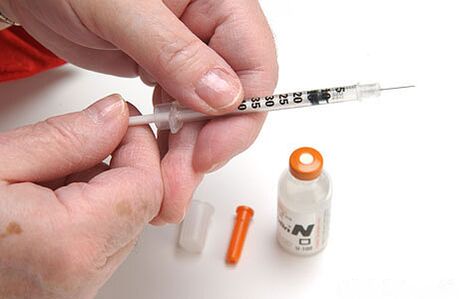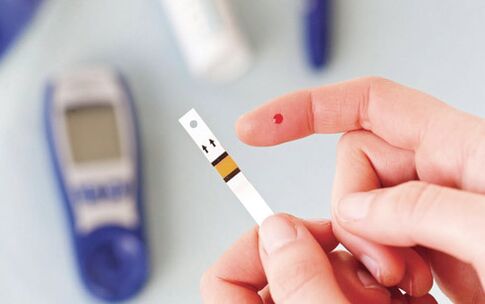Insulin - the hormonal secret of the processor, plays an important role in ensuring blood glucose stability. Diabetes Mellitus is a consequence of the deficiency of this hormone. Complications of the disease often lead to death. The main principles of the treatment of diabetes, diet or insulin injections are followed by glucose blood, watching glucose blood, watching the glucose blood, observing the glucose blood, not to miss the first signs of the complications.

Diabetes Mellitus is a continuous violation of the synthesis of insulin hormone synthesis and tissues in the body.
Insulin makes the sugar buying glucose and pass through cell membranes. Thus, the hormone reduces blood sugar degree and provides cells with nutrition. The insulin deficiency with touch sensitivity continues to keep glucose metabolism and turnover in turnover in circulation. Only the biology of carbohydrate metabolism is lost, but also oil, protein, water salt.
Sugar's rising increases the amount of lipid fractions in the bloodstitions contributing to the development of atherosclerosis. Glucose's conversion to glikogen is down and the body begins to use fat as fat. Fatty acids are fragmented and keton bodies can damage the central nervous system.
Insulin production is concerned about damage to synthesize beta cells. The main risk factor for diabetes is a significant increase in the effects of other factors. The likelihood of getting sick is growing old. Causes of diabetes:
- The failure of the immune system. Protective proteins provoke the attack of cells with a pancreas.
- The obesity. Due to the excess of adipose texture, reduces the reaction of receptors (cause of type of diabetes) due to the reason.
- Pancreatic disease. The death of cells secreted by the hormone (pancreatitis, cancer).
- Viruses infection (trade pathogens, rubella, influenza).
- Nerve tension.
The disease is available as an independent pathological role and a temporary symptom. The causes of diabetes can be the consequences of Mellitus's endocrine bodies (hypertyroidism, pheochromositoma). The symptomatic excess of glucose discovered during pregnancy (including IVF use) is called Gestational Diabetes. Hyperglisemia, when exposed to toxic substances, occurs as a side effect of certain medications (glucocorticoids, estrogen, psychotropic drugs).
Hyperglisemia, as if there is insulin errors, diabetes signals in the appearance of sugar disease.

Diabetes Mellitus is a violation of carbohydrates and water metabolism in the body.
Classification that determines the two types of two leading diseases: insulin-in-law (I wrote) and the opposite form - insulin-AVALD Diabetes (Type II). The appearance and details of the pathogenesis, the nature of the course, the characteristics of the treatment, but are different from the fact that the results are dangerous.
- Insulin-free (minors) diabetes cause the body's autoimmune aggression. The affected endocrine beta cells cannot produce insulin in the necessary doses, are required to be a permanent management. Persons under 30 are thin. The disease suddenly begins, quickly moves forward and has a heavy course.
- Insulinon - inapproximately. The reasons for this type of diabetes are heredity and obesity. Insulin can be produced in a sufficient amount, but the cells are not sensitive. This is due to a large amount of nutrition. More than 40 diabetics have a full physique. The acquired diabetes is gradually developing, steady. Most patients suffer from this disease.
The gismelite of the diabetes is determined to have complaints, which are the degree of mellitus in the glishosurtry stage, the destination of the molitus, the target of the bodies, complications, the body's compensation opportunities. There is 4 degree violence. If diabetes go to light, treatment and nutrition are properly selected. Diabetes and symptoms are depicted in the table.
| 1st (light) | Not more than 7 | Protein is normal, there is no glucosuria | No |
| 2nd (average) | 7-10 | Glucose up to 40 g / l; Ketosis and Ketoacidosis appear periodically | Heart activity, visual apparatus, nervous system, Angioneropathy Proposals |
| 3rd (heavy) | 10-14 | Continuous glucosuria 40 g / l, many protein, keton bodies | Bodies, vision, pain and painful, blood pressure increase, increase blood pressure |
| 4th (superpolate) | 15-25 | 50 g / l glucose, intense proteinuria and ketoacidosis | Strong defeat of all bodies, kidney failure, diabetic coma, gangrene, ulcerative focus on the legs |

In most cases, the clinical signs of the disease are characterized by a gradual course.
In adults, diabetes cannot immediately declare themselves that this is the development of complications. I Diabetes develops rapidly with high glycemia and coma. The intensity of the signs of diabetes obtained is associated with the depiction of insulin products, the individuality of the patient's body. If one of the symptoms appear, you must pass a test to determine the blood sugar degree.
- an unusual sense of dry mouth;
- It is impossible to reduce thirst;
- Developed Diuresis - Increased the amount of urinary demonstrated;
- speedy weight loss or weight loss;
- Itching and dry skin;
- Reduced skin sensitivity in feet;
- Compatibility, tingling in legs and arms;
- Convulsions, violence in the legs;
- Ugly skin processes arising from slow skin recovery;
- little resistance to infection;
- the feeling of hunger constantly;
- Uncertain vision;
- increased blood pressure;
- swelling of face and feet;
- Pain in the head, fainting;
- The fracture of the body acetone;
- darkening of consciousness;
- False -peritrite (fake "sharp stomach").
Diabetes Mellitus is an insidious disease. The blood sugar already harms blood vessels, causes damage to the wall. It is already converted into glucose fat deposits. It causes obesity and steatogepatose (collecting lipids in lipid cells). Glycoza leads to glycolization of membrane proteins. Oxidizing process can be impaired protein and cause toxic appearance. Defective proteins cause concerns in the structure of the organs. Accumulation of toxins and ketones, damage to the patient's nervous system, mind and comma to the disorders. Excessive blood cholesterol settles in the arterial walls in damaged areas and contributes to the anuyopathy of the eyes, legs and other organs.
The excessive degree of blood glucose levels determines the complexity of the disease.

Complex diabetes Mellitus is a life-threatening human life, so it is very important to determine the disease in time and start treatment. The disease has been aggravating for 10-15 years. Quads that look quickly and not easy to cope with their progress. Acute complications with initial diabetes (hypo and hyperglisemia) are caused by sharp fluctuations in blood sugar. List of states that complicate diabetes:
- Hypoglicemia - a sharp drop in glucose, which is less than 3 mmol / l, can cause a hypoglycemic coma.
- Hyperglycemia - Sugar Indicator ends with a hyperglycemic coma, which is above 6 MMOL / L.
- Ketoacidosis - damage neurons with keton bodies, causing someone.
- Neuropathy - Damage to the nerves of peripherals.
- Diabetic foot, trophical ulcers and the deadline of lower extremities that cause angiopathy and neuropathy.
- Neffropathy - Damage to small capillaries of kidneys violates the activities of the urine system.
- Retinopathy - Review of retina's vascular walls.
- Cardiomyopathy - disorders in heart muscle.
- Enseefalopathy - pathological on braincases.
Diabetes diagnosis determines the type, severity of the disease, the type of lesions of internal organs. Research can be repeatedly to evaluate the development of the disease and the impact of treatment. Diagnostic criteria for diabetes are the characteristic signs of diabetes and glucose lifting. To confirm diagnosis, urine and blood tests, instrumental studies:
- glucose signs in an empty stomach;
- Glycemic profile (daily vibrations);
- blood at an insulin level;
- Study of glucose tolerance, after a blank stomach, after the consumption of sugar ratio and carbohydrates;
- Analysis for glycolized hemoglobin;
- Blood for biochemistry;
- Common urinary analysis of glucose, proteins;
- Electrolyte blood test;
- Acetone indicators in the urine;
- Eye view check;
- Rebellion test for kidney damage;
- Abdominal ultraction;
- Cardogram to check the function of the heart;
- Capillarskopia, the reconstruction of the lower extremities determines the degree of defects in the vessels.
Gucose level in blood in healthy people 3. 3-5. In 5 MMOL / L.

In case of suspicion of diabetes, this diagnosis should be validated or must be refuted.
Diabetes Mellitus is a chronic pathology that should be treated for life.
Principles of diabetes - prevention of sugar control and diet in the gletar of blood circulation and preventing the diet.
An endocrinologist can be related to the disease, a cardiologist, a neuropathologist, an ophthalmologist and vascular surgeon.
Modern treatment methods - medication, diet, physical education - slows the progress of the disease.
The doctor chooses the medicine, taking into account the type of disease. Type 1 diabetes Mellitus requires only insulin therapy, 2 diabetes can be treated with sugar. Tablets move on pancreas, increase sensitivity of peripheral tissue. Such medications are used:
- Sulfanilamides.
- Biguanides.
- Preparations of insulin short and long. Simple insulin is managed 3-5 times a day and for a long period of insulin 2 doses. Perhaps the combined use of drugs.
The treatment of diabetes includes a diet with a calorie content option, except for the digestion carbohydrates, easily digested carbohydrates. Diabetes requires fractional strength. At the same time, the ratio of nutrients remains physiologically. Sugar is replaced by xylitol or sorbitol. In the middle and heavy forms of the disease, the number 9 diet is recommended. Vegetable soups, low oil fish and meat, sour dairy products and cheese, grain (buckwheat, barley oatmeal), fruits, sweet and sour taste of food. You can never eat SDoba, sweets, fatty foods, rice semolina, pasta, grapes, salted, marinated vegetables.
The formation of type 1 disease can not always be affected because it can cause a viral pathogen. The reason for the development of type 2 diabetes is considered a unhealthy lifestyle in people, especially inherited preliminary conditions. Prevention measures are diagnosed with diabetes: at least easily protect the optimal body weight in small parts of digested carbohydrates and fats. Hypertension is also implemented in the control of blood pressure numbers. From time to time, you need to donate blood for the content of glucose and lipid blood fractions. Average physical activity will help keep the body in tone.























